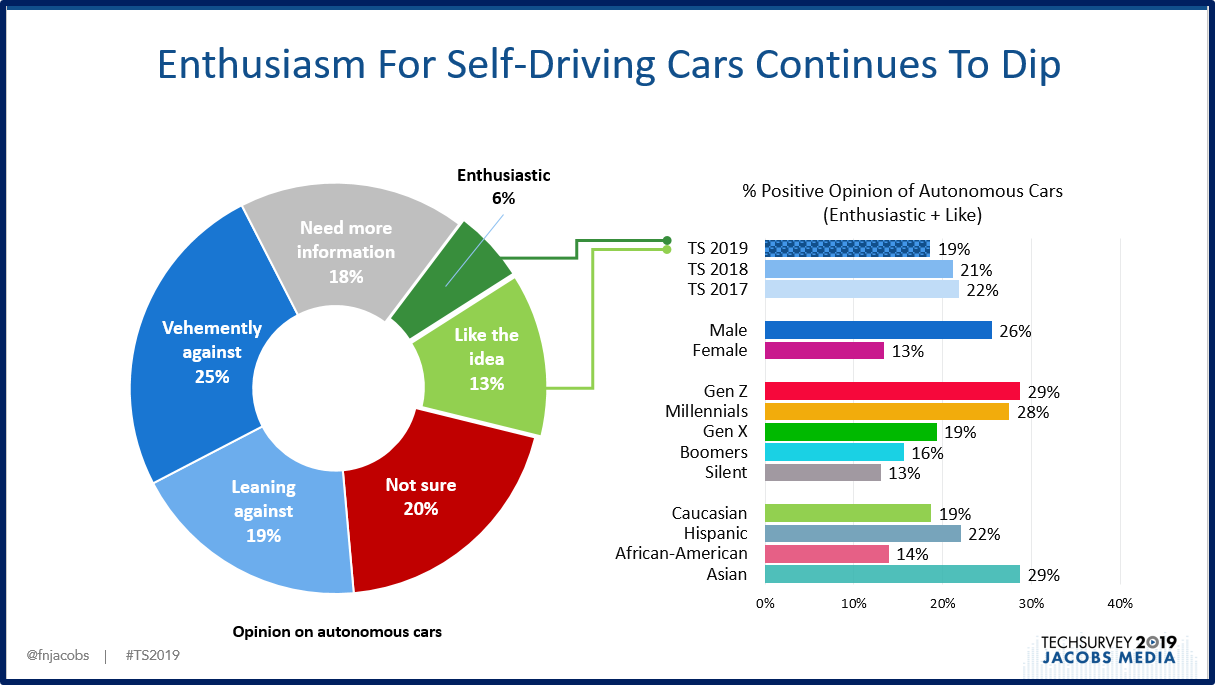
As regular readers of this blog know – probably ad nauseam – Jacobs Media’s annual treks and tours to CES are designed with one main goal in mind:
To help broadcast radio better see, understand, and grasp the future
And over the past decade, our mission has been largely successful. We’ve trend-spotted many things – connected cars, voice, video streaming services, partnerships, and bootstrap innovation, to name a few.
But sometimes you can get faked out at CES. The size, the color, the spectacle, and the excitement can lead you down a primrose path of hype. That may be happening with autonomous cars – an innovative juggernaut that has sucked billions of dollars in research and development dollars out of the car companies, Tier 1 suppliers, and other technology firms eager to crack the self-driving code.
Maybe autonomous cars have turned into a “false positive,” looking exciting on the surface but proving to be difficult for even the best of the best to get right.
Case in point: last week, Apple announced its laying off 190 employees in its Project Titan – its autonomous car initiative. Another sign these programs are under stress.
It has proved to be more difficult that it looks, not just in terms of the hardware and software involved, but also in the collective effort to convince a skeptical public that autonomous cars are indeed the next big thing.
That struck me when this video came out the day Paul and I arrived at CES back in early January. The story was that a self-driving Tesla rammed into a robot while both were on their way to the Las Vegas Convention Center. The tech who runs out to try to “save” the robot is a meme I continue to smile about two months later.
Many people believe this video is “Fake News,” and that may, in fact, be the case. But it is indicative of the way many people feel about this automotive technology. And any time a story comes out that puts autonomous cars in a bad light, the piling on begins.
Take this little item from Mashable’s Sasha Lekach – “Some self-driving car systems have trouble detecting darker skin, study says.” It turns out a research team from Georgia Tech discovered that many self-driving car technologies have more trouble recognizing pedestrians with darker skin types.
And perhaps it’s no coincidence that in our not-yet-released Techsurvey 2019, enthusiasm for autonomous cars is lowest among African-Americans. Perhaps, they are already attuned to this potential technological problem.

But in all seriousness, this data from Techsurvey 2019 reveals that positive reactions to the idea of cars driving themselves are actually ticking down with each passing year. Enthusiasm for the technology is most positive among Millennials – the generation that also most enjoys being carted around by Uber and Lyft drivers, allowing them to use their gadgetry while going from place to place.
And while the jury is out for many consumers who aren’t sure what to think about autonomous cars, one-fourth describe themselves as “vehemently against” this technology, while nearly one-fifth say they’re “leaning against” it. That’s a lot of pushback for a technology that for all practical purposes doesn’t exist yet.
Not surprisingly, we sensed a different tone this year at CES, first from automakers who are now moving their “critical mass” estimates back for autonomous way out to 2030…or beyond. And some admit self-driving vehicles may never scale as a primary form of transportation. That’s a big turnaround from just one year ago.
Our CES radio “tourists” heard a similar story from our wise Sherpa, Shawn DuBravac. At our pre-tour dinner and again as we walked through the  Las Vegas Convention Center, Shawn warned against irrational exuberance for cars that won’t need drivers. He was clearly tapping the brakes on this tech movement.
Las Vegas Convention Center, Shawn warned against irrational exuberance for cars that won’t need drivers. He was clearly tapping the brakes on this tech movement.
And while the automakers and other stakeholders continue to invest billions into autonomous technology, predictions of their dominance on America’s highways and byways is now in a lower gear. Clearly, enthusiasm for its broad societal impact has tempered.
And while most smart observers believe the dawn of 5G will usher in incredible levels of machines talking to machines, and Artificial Intelligence being shared – and created – across a wide variety of devices and gadgets, a sweeping, life-changing world of self-driving cars may be further down the road than once thought.
But here’s the kicker. While the idea of driverless cars that schlep people through America’s cities may have been tamped down, industrial applications appear to have actually accelerated.
Consider this: Apple was not at CES this year. Nor was Microsoft. But for the first time ever, John Deere showed up big time, presenting an impressive array of autonomous machinery and agricultural AI – like the massive combine you see pictured below that can perform dedicated functions for farms all over the U.S. and the world sans humans.

And they weren’t the only ones. Seth Resler ran into several companies using autonomous technology to perform dangerous tasks out in the field, under difficult conditions such as war zones or in ocean depths not safe for human exploration. Many of the same coding and logic that allows Teslas to drive themselves may have even more valuable applications to companies around the globe. Once touted as an urban transportation solution, it may ironically be in these rural or agricultural pockets where autonomous vehicles may enjoy their first wave of success and acceptance.
For broadcast radio, this may sound like a reprieve. And to some degree, it is, because any way you look at it, driverless cars will stimulate the “passenger economy” – those along for the autonomous ride. We see glimpses of the media they’ll have available to them in these vehicles by just walking the floor at CES. Cockpits with video screens and other visual media displays are commonplace in these vehicles of the future. That doesn’t bode well for broadcasters dependent on drivers, traffic jams, and other conditions that have traditionally made radio listening commonplace during commutes.
But don’t think radio is off the hook when it comes to cars. Because while autonomous technology may be idling in neutral for the moment, voice commands are very much in the driver’s seat. At CES, we encountered any number of vehicles that were multi-lingual – able to speak new languages like “Alexese” and “Googlese” so drivers and passengers can use their voices to access media of all kinds. Amazon’s Echo Auto product – an after-market solution that will bring Alexa into many vehicles – is beginning to ship.
Many of us already know what that feels like in our TV rooms where channel surfing is being replaced by more efficient voice commands. It is generally a satisfying experience that has made it easy to access content from myriad sources – cable and network channels, premium outlets, and streaming video platforms. Remotes that understand voice commands don’t care what you watch. They are source agnostic, simply helping you seamlessly access whatever you want.
generally a satisfying experience that has made it easy to access content from myriad sources – cable and network channels, premium outlets, and streaming video platforms. Remotes that understand voice commands don’t care what you watch. They are source agnostic, simply helping you seamlessly access whatever you want.
That’s the technology that’s coming to cars – not in 2030 – but right now today.
So, perhaps autonomous has had a setback. Many of the automakers’ research resembles what we’re seeing in Techsurvey. And possibly the sheer logistics of battalions of self-driving vehicles in urban areas is more complicated than first thought.
None of that will stop automotive technology from marching on.
Or in this case, driving down the media highway at increasingly faster speeds.
Buckle up.
CES for Radio Podcast
Seth Resler’s podcasts from CES are very well done, providing insight into the technologies on display at the world’s largest consumer electronics show.
You can access his two episodes on industrial use of autonomous technology below. They are both fascinating looks at these industrial applications.
[coolcastplayer id=”78″]
[coolcastplayer id=”77″]
- What To Do If Your Radio Station Goes Through A Midlife Crisis - April 25, 2025
- A 2020 Lesson?It Could All Be Gone In A Flash - April 24, 2025
- How AI Can Give Radio Personalities More…PERSONALITY - April 23, 2025




I see from the resounding lack of response that this topic is kinda like AM Stereo. HD Radio. Trying to fill a need that doesn’t exist. The world certainly hasn’t shown it’s ready to relinquish control of a two-ton hunk of metal and tech to itself. It may not happen for weeks, months or ever!
Let’s put it this way, Dave. I track the blog every day, and this was not one of our stellar posts. I think it reflects the public’s overall interest in autonomous. Thanks that at least YOU read it! 🙂
I read your stuff daily, Fred. Very provocative and informational-not always in that order. Our world is changing faster than our socks and we need to stay on top of it and keep on our toes. Lucky for us there are smart people such as you to keep us alert.
Appreciate that, Dave. As challenging and (at times) frustrating our world has become, I am excited about the future and enjoy learning as much as I can. Thanks for engaging with the blog.
Americans are very attached to their automobiles. Here in Europe the enthusiasm for autonomous vehicles is much higher, usually because it translates as ‘autonomous taxis’. Anything that clears hundreds-year old European cities of cars is a blessing. You may find that the USA lags behind other countries by years with this tech.
What is missing from the equation so far – and seems blindingly obvious to me – is personalisation. If I jump into an auto. car it’s going to know who I am. So the interior should adapt to my tastes, including my favourite radio stations. I have yet to read anything about this obvious point – because techies are always on headphones listening to their own “station” on Spotify?
John, thanks for the thoughtful comment. I don’t doubt that Americans are more “into” their cars – freedom of the highways, not to mention cars may be the last bastion of privacy. As for the media picture in these vehicles, there’s been a lot more talk about autonomous tech that what’s in the dashboard and how it will suit the “driver” or in this case, the passengers. Many believe content will be imported via mobile devices, but at this point, they seem to more focused on these cars not hitting other vehicles or people.